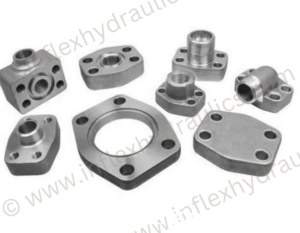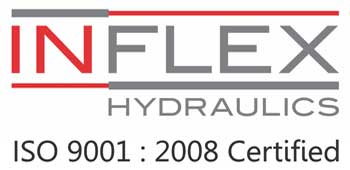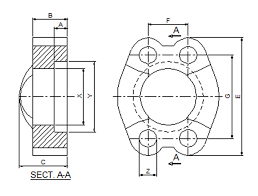SAE Flange Troubleshooting: Common Problems and Solutions
 If you’re experiencing issues with your SAE flange connections, this article is for you. We’ll explore common problems and their solutions, providing you with the troubleshooting knowledge you need.
If you’re experiencing issues with your SAE flange connections, this article is for you. We’ll explore common problems and their solutions, providing you with the troubleshooting knowledge you need.
Leaks, misalignment, corrosion, insufficient bolt torque, O-ring and gasket failures, improper installation, vibration, and contamination – we’ll cover it all.
Stay tuned for precise, logical guidance to help you resolve these SAE flange troubles efficiently.
Key Takeaways
- Leaking flange connections can result in fluid leakage, pressure loss, and damage to surrounding components. Inspect the seal for damage or wear and replace if necessary.
- Flange misalignment can lead to leakage, pressure loss, and equipment failure. Realign flanges and ensure proper bolt tightening for misalignment due to improper installation.
- Corrosion occurs when the metal surface of the flange reacts with the environment. Ensure proper sealing and drainage to prevent moisture-induced corrosion. Use insulating gaskets or corrosion inhibitors to prevent galvanic corrosion.
- Insufficient bolt torque can lead to flange leakage and operational issues. Follow the manufacturer’s recommended torque specifications and tightening sequence. O-ring failure can also lead to leaks, pressure loss, and system inefficiency. Regular inspection and maintenance of O-rings ensure reliability and longevity of the flange system.
Leaking Flange Connections
If you’re experiencing leaking flange connections, it’s likely due to a faulty seal or improper installation. A leaking flange connection can result in fluid leakage, loss of pressure, and potential damage to the surrounding components.
To address this issue, start by inspecting the seal for any signs of damage or wear. Replace the seal if necessary, ensuring that it’s compatible with the fluid being conveyed.
Additionally, check the flange connection for proper alignment and torque. Use a torque wrench to tighten the bolts to the manufacturer’s specifications, evenly distributing the torque across all bolts. It’s crucial to follow the correct installation procedure to prevent any gaps or misalignments that can lead to leakage.
Regular maintenance and inspection of flange connections can help prevent leaks and ensure optimal performance.
Flange Misalignment
When flange misalignment occurs, it is important to address the issue promptly to prevent further complications. Flange misalignment can lead to leakage, loss of pressure, and even equipment failure. There are several common causes of flange misalignment, including improper installation, thermal expansion, and equipment vibration. To troubleshoot and resolve flange misalignment, follow these steps:
| Cause | Symptoms | Solution |
|---|---|---|
| Improper Installation | Uneven gaps between flanges, misaligned bolt holes | Realign flanges, ensure proper bolt tightening |
| Thermal Expansion | Flanges have moved out of alignment due to temperature changes | Install expansion joints, provide proper insulation |
| Equipment Vibration | Flanges become misaligned due to equipment vibration | Install vibration dampers, reinforce flange connections |
Flange Corrosion
To address flange corrosion, it’s important to understand the causes and implement preventive measures. Corrosion occurs when the metal surface of the flange reacts with its environment, resulting in degradation and potential failure.
Here are five common causes of flange corrosion and their corresponding preventive measures:
- Moisture: Moisture can accelerate corrosion, so ensure proper sealing and drainage to prevent water ingress.
- Chemical exposure: Exposure to corrosive chemicals can lead to flange corrosion. Select materials with high resistance to the specific chemicals involved.
- Galvanic corrosion: When dissimilar metals come into contact, galvanic corrosion can occur. Use insulating gaskets or apply corrosion inhibitors to prevent this.
- Lack of protective coating: Apply appropriate coatings like paint or zinc plating to protect the flange surface from corrosion.
- Corrosive environments: In highly corrosive environments, consider using corrosion-resistant materials or coatings for the flange.
Insufficient Bolt Torque
Tighten the bolts securely to avoid insufficient bolt torque. Insufficient bolt torque can lead to flange leakage and other operational issues. It is crucial to ensure that the bolts are tightened properly to achieve the required clamping force and prevent any potential problems. Below is a table outlining the common causes and solutions for insufficient bolt torque:
| Causes | Solutions |
|---|---|
| 1. Improper bolt tightening technique | 1. Follow the manufacturer’s recommended torque specifications and tightening sequence |
| 2. Insufficient lubrication on the bolt threads | 2. Apply a suitable lubricant on the bolt threads to reduce friction |
| 3. Use of damaged or worn-out bolts | 3. Replace damaged or worn-out bolts with new ones |
| 4. Bolt elongation due to excessive load | 4. Determine the appropriate bolt size and material to withstand the load |
O-Ring Failure
To prevent any potential issues, ensure that you properly inspect the O-rings for any signs of failure. O-ring failure can lead to leaks, pressure loss, and system inefficiency. Here are several common signs of O-ring failure to watch out for:
- Cracks or splits on the surface of the O-ring
- Swelling or deformation of the O-ring material
- Loss of elasticity, resulting in poor sealing performance
- Hardening of the O-ring material, leading to reduced flexibility
- Discoloration or degradation of the O-ring material
If any of these signs are present, it’s important to replace the O-ring immediately.
Additionally, make sure to select the correct O-ring material for your specific application, as different materials have different chemical resistances and temperature tolerances.
Regular inspection and maintenance of O-rings will help ensure the reliability and longevity of your SAE flange system.
Flange Cracking or Damage
Inspect your flange for signs of cracking or damage. Flange cracking or damage is a common issue that can occur due to various reasons, such as excessive pressure, misalignment, or improper installation. Cracks can lead to leaks, compromised structural integrity, and potential system failure.
To identify flange cracking or damage, carefully examine the flange surface for visible cracks, fractures, or deformities. Pay close attention to areas near bolt holes, welds, or stress points. Use a magnifying glass if necessary to detect any hairline cracks that may not be visible to the naked eye.
Additionally, check for any signs of flange warping or distortion, which can indicate damage.
If any cracks or damage are found, it’s crucial to address the issue promptly to prevent further complications.
Flange Gasket Failure
If you notice any leaks or loss of pressure, it’s important to promptly address flange gasket failure. Flange gasket failure can occur due to a variety of reasons, such as improper installation or aging of the gasket material.
To troubleshoot and solve this problem, consider the following:
- Check for any visible signs of damage or wear on the gasket, such as cracks or tears.
- Ensure that the gasket is properly aligned with the flange and that it isn’t over-tightened or under-tightened.
- Verify that the gasket material is suitable for the application, taking into account factors such as temperature and pressure.
- Clean the flange surfaces thoroughly before installing a new gasket to ensure proper sealing.
- Consider using a different type of gasket material or a more robust design if gasket failure is a recurring issue.
Improper Flange Installation
If you encounter issues with your SAE flange system, one common problem to consider is improper installation of the flange.
Improper flange installation can lead to various problems such as leaks, reduced performance, and even system failure.
One possible cause of improper installation is inadequate torquing of the flange bolts. Insufficient torque can result in flange separation and leakage. Similarly, over-tightening the bolts can distort the flange and cause gasket failure.
Another common mistake isn’t aligning the flange properly during installation. Misalignment can create stress on the flange and gasket, leading to premature wear and leaks.
To avoid these issues, it’s crucial to follow the manufacturer’s specifications for torque values and alignment procedures. Additionally, ensure that the gasket is in good condition and properly seated before tightening the bolts.
Flange Vibration or Looseness
Are you experiencing flange vibration or looseness in your SAE flange system? This can be a frustrating problem, but don’t worry, there are solutions. Here are some common causes and their corresponding fixes:
- Improper torque: Check the torque on the bolts and ensure they’re tightened to the recommended specifications.
- Misalignment: Inspect the flange alignment and make any necessary adjustments to ensure proper alignment.
- Worn seals: Examine the seals for wear or damage and replace them if necessary.
- Insufficient lubrication: Lubricate the flange components to reduce friction and prevent vibration.
- Loose bolts: Tighten any loose bolts to eliminate flange movement and reduce vibration.
By addressing these issues, you can effectively resolve flange vibration or looseness in your SAE flange system.
Remember to regularly inspect and maintain your flange system to prevent future problems.
Flange Contamination or Blockage
To resolve flange contamination or blockage in your SAE flange system, address the issue of foreign material buildup. This can occur due to various reasons such as improper maintenance, inadequate filtration, or poor sealing. Contamination can lead to reduced performance, increased wear and tear, and even system failure. To prevent these issues, regular cleaning and inspection of the flange system are essential. Here are some common problems related to flange contamination or blockage, along with their solutions:
| Problem | Solution |
|---|---|
| Excessive dirt or debris in the system | Install proper filtration and regularly clean the system |
| Fluid leaks due to a damaged seal | Replace the seal and ensure proper sealing |
| Corrosion or rust buildup | Use corrosion-resistant materials and apply protective coatings |
| Contaminants entering the system during maintenance | Implement proper maintenance procedures and use clean tools |
| Improper installation leading to foreign material ingress | Ensure correct installation techniques and use appropriate gaskets |
Frequently Asked Questions
Are There Any Specific Safety Precautions That Should Be Taken When Troubleshooting SAE Flange Connections?
When troubleshooting SAE flange connections, it is important to follow specific safety precautions. Always wear protective gear, inspect the connections for leaks, and ensure the system is depressurized before beginning any troubleshooting.
How Can I Determine if the Flange Misalignment Is Causing the Leak or if There Is Another Issue?
To determine if flange misalignment or another issue is causing the leak, inspect the flange for any visible signs of misalignment. Check for uneven gaps or misaligned bolt holes. If the flange appears aligned, investigate other potential causes.
What Are the Different Types of Corrosion That Can Affect SAE Flanges and How Can They Be Prevented?
To prevent corrosion on SAE flanges, you should know the different types that can affect them. This knowledge will help you implement preventive measures and maintain the integrity of the flanges.
Can Insufficient Bolt Torque Lead to Other Problems Besides Leaking Flange Connections?
Insufficient bolt torque in SAE flange connections may result in various issues beyond leaks. These problems can include loosening of the bolts, misalignment of the flanges, and decreased overall performance of the system.
Is There a Way to Identify O-Ring Failure Before It Causes a Major Issue With the SAE Flange?
To identify o-ring failure before it causes a major issue with the SAE flange, you should regularly inspect the o-ring for signs of damage, wear, or deterioration. This can help prevent potential problems down the line.
Conclusion
In conclusion, addressing and troubleshooting common problems with SAE flange connections is essential for ensuring their proper functionality and preventing issues such as:
- leaking
- misalignment
- corrosion
- insufficient bolt torque
- O-ring and gasket failure
- improper installation
- vibration
- contamination
By identifying these problems and implementing the appropriate solutions, the overall performance and reliability of SAE flange connections can be significantly improved, leading to more efficient and safe operations.
All you needed to know about Hydraulic SAE flanges.
Everything you wanted to know about Hydraulic SAE Flanges!
What is a Vacuum Flange? Find out on Wiki by clicking here…
Choose the right SAE Flange based on Pressure ratings. Click here.

